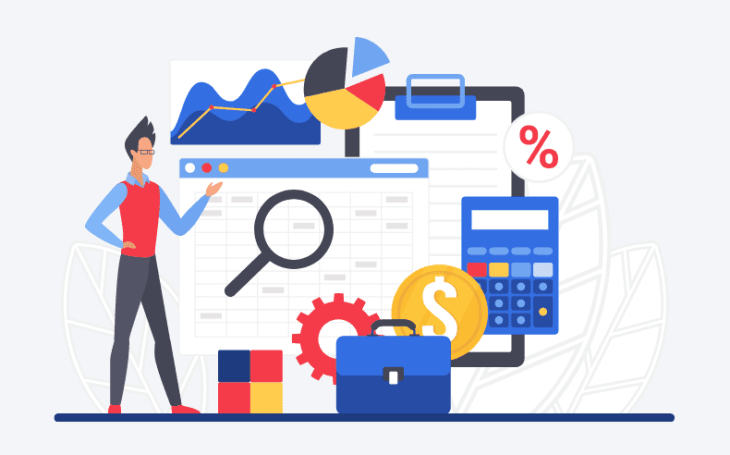Key Variables Used in Bank Statement Analysis (For Individuals & Businesses)
Identity of the Bank Statements
When we analyze bank statements, it’s really important to figure out who the account belongs to. We can do this by looking at a few important things. First, we check the “Transaction Status” to see if the bank has processed the transactions properly. It can show if things are still being worked on (processing), if everything’s done (completed), or if there are problems (failed).
Next, we gather the “Account Holder Name” and “Address” from the statement itself. These tell us who owns the account and where they live. It’s like confirming someone’s identity.
Then, there’s the “Account Number.” It’s like a special code for the bank account. Just like how each person has a unique phone number, each account has its own special number.
Lastly, we consider the “Account Category.” This tells us if the account is for a single person (“Individual“) or for a company (“Corporate“).
So, all of these things together – the Transaction Status, Account Holder Name, Address, Account Number, and Account Category – help us understand and confirm the identity of the account owner when we’re studying bank statements.
Monthly Income
Monthly income indicates the income credited to the account regularly. It helps in evaluating the customer’s income stability and repayment capacity.
Lenders often set a minimum income threshold to ensure borrowers can comfortably handle loan EMIs. This is particularly important for personal loans, where higher income signifies lower risk for lenders. Salaried professionals usually need a minimum monthly salary of INR 15,000, while INR 25,000 or more is preferred. Self-employed individuals typically require a gross annual income of Rs. 2 lakh or higher, with some lenders not publicly disclosing their criteria.
Home loan eligibility can be determined using the multiplier method, where an applicant’s monthly income is multiplied by 60-70 times or their annual income by 6. This calculation helps lenders establish the maximum loan amount a borrower qualifies for, ensuring they have the income to manage repayments effectively.
Bill Payments
This parameter reflects the regular payments made towards utility bills, subscriptions, and other recurring expenses. Monitoring bill payments is essential to understand the customer’s financial discipline and obligations.
Cash Withdrawals
Cash withdrawals indicate the amount of cash taken out from ATMs or over-the-counter transactions. It helps in evaluating cash usage patterns and liquidity management.
Total Debit Card Spends
It shows the overall expenditure made using the debit card. This information assists in understanding the customer’s spending habits and preferences.
Monthly EMI
EMI (Equated Monthly Installment) represents the regular instalment payments made towards loans or credit purchases in a month. Analyzing it helps to assess the borrower’s repayment behaviour and overall debt burden.
The analysis of the repayment capacity depends on lenders to lenders. Ideally, the total monthly EMIs for all loans should be between 30-55% of monthly income. For short-term loans below 2 years, the total EMI should not exceed 35%. For long-term loans, upto 50%-55% is considered as the ideal permissible EMI ratio, as said by Paisabazaar. For home loans, the proposed repayment capacity is a 50-60% EMI ratio. This ensures a balanced financial situation and that enough money remains after paying off all the EMIs.
Credit Card Payments
This parameter represents the payments made towards credit card bills. Analyzing credit card payments is important to assess the customer’s creditworthiness and financial responsibility.
Monthly Expenses
Monthly expenses represent the total amount spent on various items during a month. Analyzing this helps in budgeting and understanding spending patterns.
Monthly Transactions (Debit & Credit)
This parameter reflects the total number of debit and credit transactions made in a month. It helps in understanding the account’s activity level and usage.
Cash Deposited
Cash deposited represents the inflow of cash into the account. Monitoring cash deposits helps in tracking the sources of income and detecting any irregularities.
Investments Cash-Ins
This parameter shows the cash received from investments such as fixed deposits, mutual funds, or stocks. It helps in assessing the customer’s investment behaviour and additional income sources.
Purchases Through Payment Gateway
This parameter indicates online purchases made using payment gateways. It assists in understanding the customer’s online spending habits and e-commerce preferences.
Refunds
Refunds show the amount credited back to the account due to returned goods or cancelled transactions. Tracking refunds helps in managing cash flows and identifying potential issues.
Transactions Through UPI
This parameter represents transactions made using Unified Payments Interface (UPI). UPI transactions have become popular, and analyzing them provides insights into the customer’s digital payment behaviour.
Expense-to-Income Ratio
The Expense to Income Ratio is a metric that assesses a customer’s financial well-being by analyzing the ratio of their monthly expenses to their monthly income. This provides valuable insights into their financial management capabilities.
Ideally, it is said that 50% of someone’s income should go towards expenses. Hence, the 28/36 Rule offers a practical guideline for determining a reasonable level of debt for individuals or households. According to this rule, a maximum of 28% of gross monthly income should be allocated to total housing expenses, and the total debt service should not exceed 36%. This rule ensures a balanced approach to financial commitments and aligns with the broader goal of maintaining a healthy Expense to Income Ratio.
Monthly Closing Balance
The closing balance at the end of each month shows the funds available after accounting for all transactions. It is a key indicator of the account’s financial health and stability.
Bounces
Types:
- Debit bounces occur when there are insufficient funds in the account to cover a debit transaction. Monitoring debit bounces is crucial for assessing the customer’s financial stability and risk profile.
- Cheque bounces occur when an issued cheque cannot be processed due to insufficient funds. Monitoring cheque bounces is crucial for assessing the customer’s payment reliability. For individuals, inward bounces are taken into consideration. Outward bounces are considered for businesses regarding working capital finance.
- EMI bounces occur when the customer fails to pay their loan instalment on time. Monitoring EMI bounces helps in assessing the borrower’s credit discipline and repayment capability.
Inclusive of all the bounces, the number of bounces should be 0 for short-term credit. For long-term credit, the number should be a maximum of 2.
Loan Credits
Loan credits show the disbursement of loans or any other borrowings into the account. It assists in tracking the inflow of borrowed funds.
Cheque Deposit
Cheque deposits show the inflow of funds through deposited cheques. It assists in tracking incoming payments.
Cheque Issue
Cheque issues represent the outflow of funds through issued cheques. Monitoring this helps in managing cash flows and payments.
Other Things To Consider in Bank Statement Analysis (For Businesses)
The process of analyzing bank statements for business shares similarities with the evaluation done for individuals, as both employ comparable parameters for their assessments. However, there are subtle distinctions between the two, which we shall now emphasize.
The cash flow cycle of a business plays a crucial role in sustaining ongoing operations, corporate growth, loan repayments, and profit generation. When seeking a business loan, lenders rely on bank statement analysis to understand how the funds will be utilized and evaluate the applicant’s financial stability. Here’s how this assessment is carried out:
Cash Balance
A positive cash balance in the bank account signals accessible funds and responsible financial management. It increases the likelihood of loan repayment. Lenders also examine receivables and payables financing to gauge transaction history and credibility.
Deposits
Recurring deposits on the bank statement indicate consistent income sources, showing the ability to repay the loan on time. Unusual or infrequent deposits can raise concerns for lenders.
Withdrawals & Liabilities
Large or frequent withdrawals, especially of consistent amounts, may indicate hidden debts or recurring obligations. Business liabilities, such as hire purchase and office leasing, are also scrutinized.
Cash Overdraft
Cash overdrafts, where the applicant withdraws more than the available balance, raise red flags for lenders, suggesting financial mismanagement and repayment challenges.
Bounced Penal Transactions
Bounced checks are a concern, as they indicate insufficient funds or financial instability. No check bounces demonstrate a healthy financial aspect.
Fraud Control Unit (FCU) Indicators
These indicators highlight potential suspicious transactions and fraud in financial management. Factors like salary credits, ATM withdrawals, holiday RTGS funds, irregularities in money transfers, interest charges, and negative balances are closely monitored to identify fraudulent activities.





